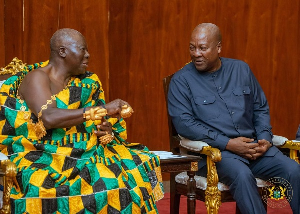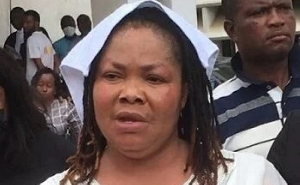By Lepowura M. N. D. Jawula
It might appear that, in Gonja the demise of one King (the Yagbonwura) leads to the succession of the next in coming Yagbonwura. In one sense it is that simple, but in another sense it is the consultative process among chiefs and kingmakers as well as the urge by all and sundry to have a peaceful process of succession that makes the Gonja system appear to work like a loom. Owing to the belligerency of the olden times, it was necessary for a replacement King to be in place within seven days of the death of the king or any of the Divisional Paramountcies in order that the system would not be overtaken by attacks from neighbouring states or by internal schisms.
The Gonja people, who are one of the twenty six or more guan ethnic groups, appeared in modern Ghana very early in the 16th Century. It is indeed common historical knowledge that the Gonjas or the larger Guan group were the first residents of the geographical area now called Ghana. It is worthy to note that Gonja history has been recorded by Islamic Scholars who were embedded in the Gonja army as it left ancient Mande in Mali and travelled through Segu in Southern Mali and approached the Bole area through La Cote d’Ivoire, the Sissala area and Wa in modern Upper West.
The Mandingo forces that entered modern Ghana with all the other allies, too numerous to mention here, arrived under the leadership of the leader of the Mandingo expeditionary forces from the old Songhai Empire in 1546. That was the climax of the Songhai Empire and even though oral tradition on this is totally accurate, one would expect that internecine tribal activities would have led to movements of some groups from the centre of power or conflict. We should also note that the great Askia Mohammed had been on the throne for thirty-five years by 1528. Owing to Askia Mohammed’s ill health and infirmity, his son Musa and his nephew Askia Bankouri and yet another son Askia Ismail fought over power and turned the throne into a political football. Instability in Songhai continued until the reign of Askia Daud which restored normalcy in the Kingdom around 1581.
In the course of these turbulent times at headquarters, the breakaway group in the diaspora was establishing herself firmly in present Gonjaland with the reign of Landa from 1546 to 1576.
After Landa, Wam reigned for nineteen years from 1576 to 1595. Chari reigned for forty years from 1595 to 1615, then followed Amoah (Alhaji Imoru Seidu) 1615 to 1634 and then to Lanta Limu, 1634 to 1675; the father of the legendary leader, Ndewura Jakpa. Indeed Lanta Limu abdicated in favour of Jakpa who reigned from1675 to 1697.
As Jakpa embarked on the conquest of the current vast Gonjaland and even beyond, he cultivated the practice of installing his sons in what has come to be known as divisions. These divisions which have survived conflicts, European rule and even modern governance are Wasipe (Daboya), Kpembe, Bole, Tuluwe, Kong, Kadia and Kusawgu. To this day the paramount chiefs who head these divisions refer to the Yagbonwura as their father.
Within the divisions there are sub-divisions which also have a system of rotation mirrored on the rotational system at the divisions and the Kingship.
Over the years therefore, the various divisions ascend to the Yagbon skins by rotation starting from Wasipe and ending at Kusawgu. With the demise of a Kusawgu candidate the rotation begins again from Daboya and goes down the line. Any attempt to break the succession always led to disaster whether the attempt was made in the divisions or at the Gonja State level. The succession continued smoothly except in a few instances until 1830 when, Nyantakyi of Kong ascended the throne and on his demise it passed over to Tuluwe and then to Kusawgu. A dispute arose between Bole and Kong over succession and Kong did the unimaginable by soliciting external assistance from the notorious slave raider Samori and Kadia. Samori and the Kong people were defeated and this led to the expulsion of Kong and Kadia from the Kingship. That therefore reduced the divisions from seven (7) to five (5) i.e. Wasipe, Kpembe, Bole, Tuluwe and Kusawgu. Tuluwe and Kusawgu came to the throne thereafter in succession.
Owing to the civil war situation created by Kong, Gonja suffered bouts of instability with Kurbang Seidu Dushi, Puntong Prong (Abudu) Lanyon and Mahama Dangboga all from Bole ascending the throne between 1860 and 1937.
Around this period the British Colonial authorities were firmly in control in the then Northern Territories and they decided in 1930 to document the Gonja and Dagomba methods of chiefly succession “with a view to introducing indirect Rule as soon as possible”.
The Gonja Conference was held in Yapei under the auspices of the Ag Commissioner of the Southern Province Sir Duncan-Johnstone. The Gonja and Dagomba Constitutions were drawn and accepted by the ethnic groups culminating in a report entitled “Enquiry into the Constitution and Organization of the Dagbon Kingdom (Government Press 1932) and for the Gonjas “Enquiry into the Constitution and Organization of the Gbanye Kingdom (Government Press 1932). This document for the Gonjas has been the alpha and omega of chiefly succession in modern times.
With the demise of Yagbonwura Mahama, Kpembewura Isanwurfor declined ascension to Yagbon saying he was happy to remain at Kpembe. Iddi Bambaga (1937-1942) of Tuluwe therefore took over the reigns and thereafter Soale Lanyo of Kusawgu (1942-1943) and thence to Awusi Ewuntomah of Wasipe (1943-1975) Owing to the Yapei agreement, when the skin became vacant in 1975, Kpembewura Jawula Ababio II of Kpembe put up claims for the skins, but the Kingmakers were not supportive because he was infirm at the time. It was agreed then for the skins to be taken up by Kurabaso of Bole with the proviso that if a vacancy was created in the future Kpembe would have the first shot, provided the chief was healthy enough to handle the affairs of the state. Kurabaso reigned between 1975 and 1982. As fate would have it, when the skins were vacant this time, Kpembewura Timu I (Mr. J. A. Braimah) became Yagbonwura. The rotation continued thereafter to Tuluwe (Kanyiti, 1987-1990), Kusawgu (Biyawurbi; 1990-1992). Wasipe (Aliadengyi; 1992-1993), Bole (Bore Enyi Nche; 1993-1998) and then to Kpembe (Bawah Doshie; 1999-2010).
The actual processes or rites for the funeral and nomination of the out-going Yagbonwura and the in-coming one are clearly spelt out and imbibed by all Gonjas young and old, ordinary citizens, chiefs and elders. On the demise of the old man, an unbridled horse is sent to the Buipewura at Buipe. On seeing the horse the Buipewura, who is the Vice President of the Gonja Traditional Council is made aware that the King has gone to the bush and has not returned home. This is the notice to the Buipewura for the official announcement and for a message to be sent to the Senyowura who begins to act as Yagbonwura until a new king is installed. It should be noted that by tradition the Yagbonwura and the Buipewura never see each other while they hold those positions, so as soon as the Yagbonwura appoints a Buipewura, that ends physical contact with the Buipewura. They can attend meetings together but a partition must be put between them. It should be possible to explain this phenomenon and others in another piece.
The other reason why the Buipewura should be informed early enough is because the chief responsible for putting the final gown on the newly in-skinned Yagbonwura is the Kagapewura, who is under the control of the Buipewura. If the Buipewura does not instruct the Kagapewura to proceed to Nyanga for the enskinment ceremony, the ceremony would not be valid.
The funeral of the Yagbonwura is performed on the third day and seventh day. In modern times because a lot of people including government officials and neighbouring ethnic groups must be invited, the seventh day could be delayed or negotiated so that various interest groups could be invited. Over the years, Gonjas wish to see at the funeral, Government Representatives, the Otumfuo Asantehene’s delegation, the Dagomba Delegation, the Mamprusi Delegation, the Wala Delegation, the Grushie Delegation (the Kasenas, Sissalas and Builsas), the Chokosi Delegation and the Wangara delegation. Many more too numerous to mention are expected to attend.
The seventh day funeral is very important because soon after the funeral, the very next day, the Kingmakers comprising the Senyowura presiding, the Damangowura, the Choriwura, the Kpansheguwura, Mankpanwura and Kulaw-wura must meet to select the successor. It should not be mistaken that because of the strict rotation system this meeting is as easy as expected. Even though Gonjas practice a rotation system, there is also a clause for disqualification. In the event of disqualification the skin moves to the next gate, or the one after et cetera. That explains why Kingmakers sometimes have a hard time. Some lobbying would usually take place during the funeral prior to the meeting of the Kingmakers. In modern times the biggest point of disqualification is the infirmity of the candidate. Infirmity is not the main issue. The issue is that the new candidate must have the correct numbers of fingers and toes and must be able to wear sandals that clearly denote his toes and must be able to walk. Other interesting points of qualification too many to mention here, exist.
The inability of Jawula Ababio to ascend to Yagbon because he was then incapacitated has become a cause celebri which was cited copiously in decisions taken by the Kingmakers in the past few weeks. This made it possible for the rotation to shift from Tuluwe to Kusawgu. We are in modern times with lots of educated Gonjas who know their rights, so there was quite some initial noise and objections from Tuluwe. In the course of that crucial night however, issues were sorted out, assurances were made and by the next morning Kusawguwura Suleman Jakpa was confirmed as the next Yagbonwura. The Yagbonwura elect has accordingly performed the twelfth day funeral of his predecessor and Gonja and the world await his date of investiture at Nyanga. The necessary documentations exist which will give the next opportunity to Tuluwe, once they have a healthy candidate. This is a clear example of a convention that has come to stay to bring about stability in the selection of Kings in Gonjaland. In so far as Gonjas have agreed to go by the rotation, it should be expected that Kingmakers would have to take decisions on chiefs who are well as well as those who are unwell. The important issue in all this is that there should be precedents that fall into place and that bring succor to the Gonja body politic.
The colonialist initiative of 1930 did well in putting our succession into perspective; otherwise a near five hundred year civilization had begun to disintegrate at some point in time in the 1830’s. With the information highway now in existence we should begin to understand why Prince Charles is next in succession and Prince Edward next after him. Rotation is not peculiar to Gonja. Na Gbewaa’s people; the Mamprusis, Dagombas, Nanumbas and even the Mossis also have systems that rotate. The Mamprugu traditional area for instance started with two ruling houses, these have metamorphosed into four. In so far as they can see their way clear, I believe every Mamprusi has an idea exactly which gate takes over from the current Na Sheriga occupant.
Chieftaincy is evolutionary, so anything is possible. The Gonja system started with seven ruling houses, and then circumstances reduced them to five. The Kongwura and Kadiawura have now taken their positions in the Gonja Traditional Council and have been visible in the past few years. Perhaps a day may come when they might appeal to join the system.
For Gonja, the people are rejoicing that Bawah Doshie went past the one hundred year mark, and we now have by Gonja standards a much younger King at seventy-five years. Let’s hail Yagbonwura Suleman Jakpa. May his reign be long.
Lepowura M. N. D. is a member of the Kpembe Traditional Council and a Graduate Student in Social Policy at the University of Ghana, Legon.
Opinions of Saturday, 6 February 2010
Columnist: Jawula, Lepowura M. N. D.














